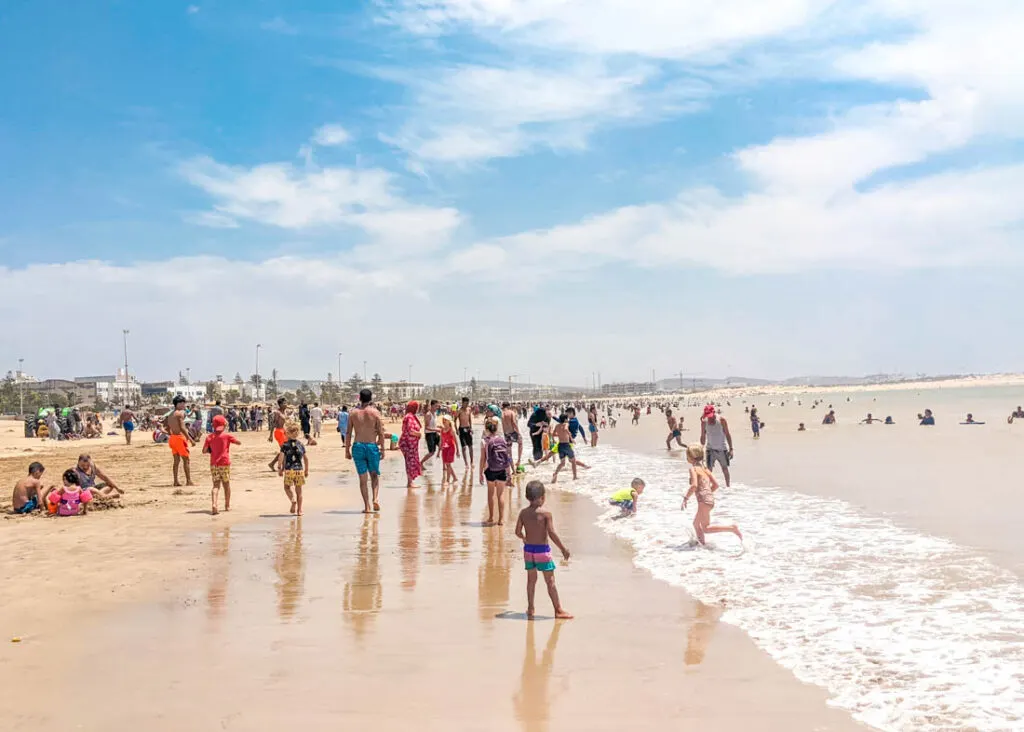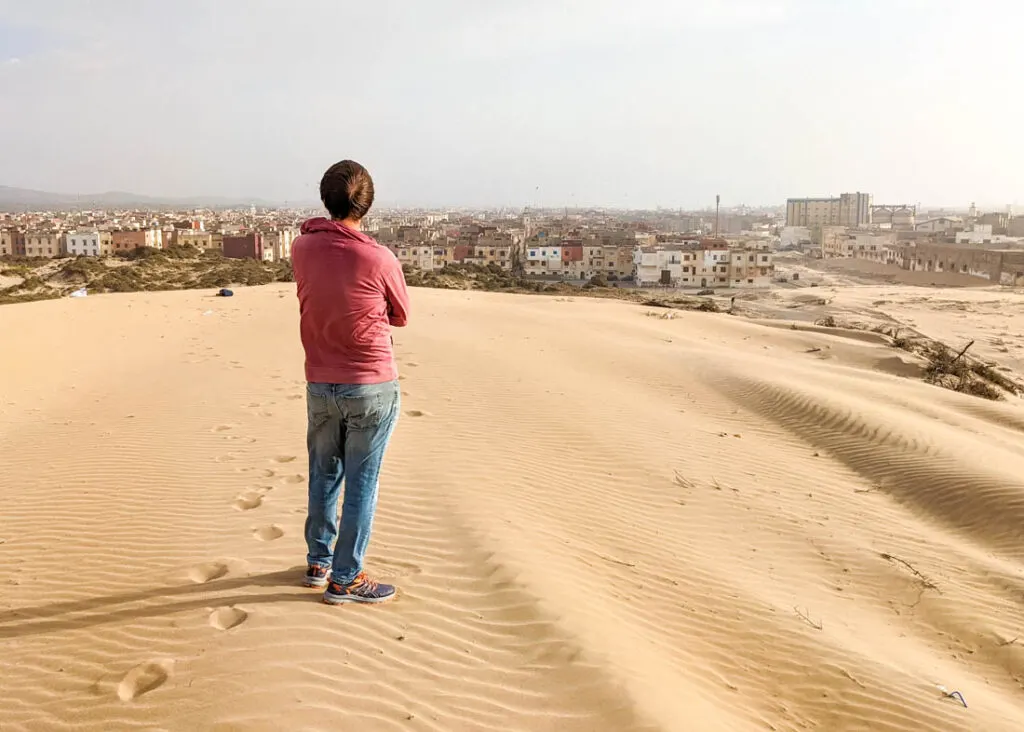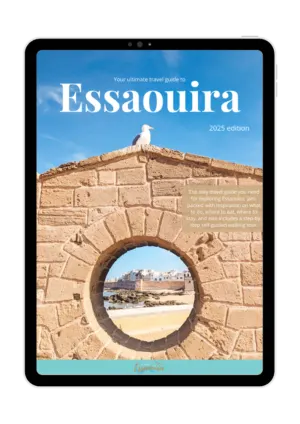Follow Explore Essaouira on Instagram
Essaouira has something to offer visitors throughout the year but the best time to visit is September and October, when the crowds and wind have died down, but the weather, beach and medina are still at their most appealing.
Thanks to its location on the Atlantic coast, Essaouira doesn’t experience the extreme temperatures of other Moroccan destinations inland, such as Marrakech, Fez, and especially the Sahara. With an average of 300 days of sunshine and with so many things to do, it’s a great year-round destination. But taking into consideration other factors such as school holidays, wind, and religious festivals… when is the best time to visit Essaouira? Well read on…
January is the coolest month with an average temperature of 19C (66F) (perfect for some winter sun, although make sure you pack a jumper). In the summer months of July and August, the average temperature is 28C (82F). July and August are also the high season when Essaouira is extremely busy with both international tourists on their summer holidays and domestic tourists fleeing the suffocating inland heat during the Moroccan school holidays. As a result, expect accommodation prices to rise.
However, the wind can make all the difference to how warm (or cold) it feels in Essaouira, especially on the exposed beach. Essaouira has been coined the ‘Windy City of Africa‘ and it certainly feels apt when that Atlantic breeze blows off the cobwebs. But this is also why Essaouira’s beaches are popular with surfers (including kite surfers and wind surfers). Once the summer months have passed, the wind drops considerably in September and even more so in October.
Essaouira does experience some cloudy and drizzly days, which leads to occasional rainy days, although heavy rainfall is very rare. Drizzly days are more frequent between December and February, but this only equates to a couple of rainy days per month. Generally you can expect the sun to be shining for your visit to Essaouira, even if you’re just visiting Essaouira for a day or two.
How much impact does the weather have on your Essaouira trip?
The weather in Essaouira is relatively consistent, avoiding many of the extreme temperatures found elsewhere on the continent. But that doesn’t mean you can ignore the weather, nor how it might impact your trip. Many a visitor before you have shivered in a riad in January, or wished they’d brought a sarong to cover their face during a particularly windy August afternoon on the beach. So it pays to be forewarned, if for no other reason that you’ll know what to pack and what to wear in Essaouira.
Average temperatures in Essaouira
This graph shows the historical average temperatures for Essaouira. As you can see, there isn’t a huge range in the temperatures throughout the year, going from 19C up to 28C.

Essaouira experiences a classic maritime climate, with mild temperatures year-round and a much smaller annual temperature range compared to central Morocco, due to the effects of the Atlantic Ocean.
As the graph shows, whilst temperatures soar to 40C (104F) in the summer across central Morocco (such as in Marrakech and Fes), the summer temperatures in Essaouira are a very pleasant and relatively comfortable 28C (82F).
And on the other end of the scale, when evening temperatures can drop to single digits in central Morocco, the evening temperatures are very comfortable in Essaouira in winter.
However, the wind can make a huge difference to how warm (or cold) it may feel, and even in the summer months, you will need a light jumper in the evenings. Do check out our guide: what to wear in Essaouira but, the takeaway is that layers are key all year round.
Wind in Essaouira
And let’s talk about the wind in Essaouira. This picturesque town perched on the Atlantic coast in known as the ‘Windy City of Africa’ for good reason!
The graph below displays the average and maximum wind speeds in Essaouira, and also the average gusts. Check out the average gusts for July!

July and August are typically the windiest months, which is great for kite-surfing in Essaouira, but perhaps not so great for sunbathers. In fact, it’s the wind that keeps Essaouira off the list for those tourists that feel the need to work on their tan; you will be covered in sand, with the grains finding their way into every crevice, after five minutes of ‘sunbathing’.
That’s not to say that every day is windy; even July and August have days where the wind drops considerably and September / October / November are relatively calm months.
In the summer months at weekends, it’s the wind that dictates how busy Essaouira gets with domestic tourists. If the wind is blowing a gale, the beach will be significantly quieter. However, if you wake up to a still day on a summer weekend, prepare for huge crowds of local tourists on the beach by 2pm.
Does it rain in Essaouira?
Yes, but very infrequently, with only two days rain per month on average during the winter months.
The below graph displays the average rainfall for Essaouira.

These drizzly days aren’t without their charm though, partly because they’re so infrequent that they have a novelty factor. It’s an eerie and disorienting sight when the mist rolls in off the Atlantic Ocean and the beach and medina are covered in a white blanket. Sometimes you can only see a few metres in front of you when standing on the shoreline, and your clothes and hair begin to feel damp. It’s quite a magical experience. Appreciate it while you can, before long the mist clears and blue skies are revealed one again.
School holidays in Essaouira
Schools holidays vary slightly between French schools and Moroccan (local) schools, but commonly they follow the same pattern as schools in Europe with a long summer break, plus a shorter winter break and spring break. There are also the half-term (mid-term) breaks.
The school holiday you need to be most aware of for your visit to Essaouira, is the summer holidays, which runs through much of July and August. This is a time when domestic tourism is booming in Essaouira as Moroccans flee to the coast for the cooler temperatures; the beach is packed, restaurants are full, and there’s a very busy, energetic vibe everywhere.

However, it’s still possible to escape the summer holiday crowds. Either venture up to Assafi Beach to the north of town; there’s an end-of-the-world feel there, where fewer visitors venture. Otherwise, base yourselves in Diabat, the sleepy village just south of Essaouira along the coast. Within Essaouira itself, the early mornings are still relatively quiet.

Religious festivals in Essaouira
During religious festivals, shops and business close (or have very limited opening hours), and this includes many of the restaurants. These are also times when it’s very difficult to find alcohol in Essaouira; shops selling alcohol close, although it is still served in tourist hotels.
Ramadan in Essaouira
READ OUR GUIDE: Essaouira during Ramadan
The main religious festival to consider for your visit to Essaouira is Ramadan. This is a time of great religious significance for Muslims, and involves fasting from dusk until dawn (this means no food or drink, including water).
For 2026, Ramadan in Morocco begins in the evening of Tuesday, 17th February and will continue for 30 days until Thursday, 19th March, although these dates a subject to slight change according to moon sightings.
We once considered Ramadan a great time to visit Essaouira for a quieter, more peaceful experience. However, in recent years, the city has remained fairly busy. This was initially influenced by Ramadan coinciding with Easter in 2023 and 2024, but even in 2025, visitor numbers remained steady. That said, Essaouira is still far less crowded than the peak summer months of July and August, and early mornings remain pleasantly quiet with fewer tourists around.
However, whether it’s quiet or a little busy, visiting Essaouira during Ramadan enables you to witness a truly sacred time of year in the Muslim calendar.


Eid al-Adha in Essaouira
READ OUR GUIDE: Essaouira during Eid al-Adha
Another festival to consider is Eid al-Adha (‘the feast of sacrifice’), when there is a tradition of sacrificing a sheep (or camel or goat) to share amongst family, friends, and those in need to commemorate Allah allowing Ibrahim to sacrifice a ram instead of his son.
Eid al-Adha is a much shorter festival than Ramadan and is officially a two-day public holiday across Morocco. During these two days, banks, post offices, and public offices are closed, along with many shop and restaurants, and other businesses (including Carrefour). In fact, many businesses close for up to five days as people take an extended holiday.
For 2025, Eid al-Adha in Morocco will begin on the evening of Friday to 6th June and continue to Saturday 7th June.
Cultural and music festivals in Essaouira
The most significant music festival in Essaouira is the Gnaoua World Music Festival, held in the city at the end of June each year. This festival focuses on Gnawa musicians and is the best place in the world to witness this unique and distinct artform.

Close to half a million visitors descend on the city each June, so it’s vital you book accommodation as far in advance as possible; don’t expect to arrive a few days beforehand and find somewhere to stay. The vibe of the city is transformed for these few days and it’s not to everyone’s taste. The city strains under the weight of all the extra visitors and it loses most of its relaxed atmosphere. Consider beforehand if this sounds like a positive or negative, and plan your visit accordingly.
Monthly guides to Essaouira
The following is a break down of what you can expect each month in Essaouira, including weather and festivals to note. Do click on on the specific guide for each month for more in-depth discussion.
January in Essaouira: Mild winter weather, with cool breezes and day time temperatures around 19°C (66°F). It’s a quiet, off-season time to visit and promises a refreshing start to the year. Wearing layers is a good idea. You will need a jacket for the evenings.
February in Essaouira: February’s weather is much like January, with daytime temperatures around 19°C (66°F). However, visitor numbers tend to rise slightly due to European school holidays (February half term). If winter feels endless and you’re longing for some sun, Essaouira makes for a perfect escape. Keep in mind that in 2026, Ramadan begins on February 17th.
March in Essaouira: As temperatures rise above 20°C (68°F) and sunshine becomes more frequent, Essaouira starts to feel the warmth of spring. In 2026, Ramadan will partially fall in March, ending on the 19th. While some restaurants and businesses may close during this time, the city remains very much open to tourists.
April in Essaouira: Coinciding with Easter public holiday days, there is an influx of tourists to the city in April. It’s also the month where, if you’re lucky, it may feel warm enough for sunbathing, although there are the odd day when sea mist rolls in to envelope the city.
May in Essaouira: Average daytime temperatures have warmed to a very lovely 24°C/75°F, although with the increased wind, the weather can be rather unpredictable from calm sunny days to cloudy windy days, although rain is very unlikely.
June in Essaouira: A lovely time of year to visit Essaouira in terms of temperatures and climate, although you need to be aware of two festivals (Eid al-Adha and Gnaoua World Music Festival). Also, the Atlantic winds strengthen throughout June and the city sees an influx of kite-surfers.
July in Essaouira: Warm, sunny days are pretty much guaranteed every day, but as we move into summer holidays, Essaouira gets exceptionally busy, increased with locals flocking to the beach to cool down from soaring inland temperatures. Also, the Atlantic winds have picked up and are very strong.
August in Essaouira: Peak season for both international and domestic tourists and the city is busy. Accommodations get booked up quickly and you need make dinner reservations at upmarket/tourist restaurants. The winds are very strong throughout August, but they are very welcomed if you’ve been travelling inland in Morocco.
September in Essaouira: With the summer crowds gone, continued warm temperatures hovering around 26°C/78°F, and the promise of a drop in wind , September is one of the best months to visit Essaouira.
October in Essaouira: Arguably the best month to visit. Those infamous winds off the Atlantic have subsided, the daytime temperature hovers around 25°C/77°F, and the summer crowds are a distant memory.
November in Essaouira: The perfect time for northern Europeans needing an extra dose of Vitamin D before Christmas, and a quieter time to explore. Average daily temperatures drop to a still very pleasing 22°C/71°F, although a light jacket for the early mornings and evenings may be needed.
December in Essaouira: Weather can be rather unpredictable. Mostly the days offer bright blue skies and calmer winds, but you can expect the odd drizzly grey day, and some days when the weather can’t make up it’s mind as to what it wants to do. Layers are your friend at this time of year.
When is the best time to visit Essaouira?
Taking into consideration sunshine, warmth, sea temperature, wind, religious festivals, and crowds, we consider September or October are the best time to visit Essaouira.
This is when the summer crowds have dissipated, but the days are still long and warm, and most importantly, the wind has dropped considerably. However, if you are visiting Essaouira for surfing or kite-surfing, this perhaps isn’t the best time as there is less wind for kites to utilise and the surf is much gentler (although this is a good time for absolute beginner surfers).

If you’re not too worried about the wind (indeed, this is very much part of what makes Essaouira, Essaouira) then April to June is also a good time as the the main beach and medina are much quieter.
However, in all honesty, each month has it’s advantages and disadvantages, and there is no bad month to visit Essaouira.
-
 Explore Essaouira ebook£16.95
Explore Essaouira ebook£16.95
Explore Essaouira ebook
Updated for 2025, the Explore Essaouira ebook is the only travel guide you need for exploring Essaouira. It is jam-packed with inspiration on what to do, where to eat, where to stay, and also includes the step-by-step self-guided walking tour (with photos).
This is a PDF download for use offline and on the go (and ad-free!). Save it to read on the plane to Morocco, download to your phone to follow the self-guided walking tour around the medina, or print it off at home before you leave on your adventures and highlight all the bits you want to remember for your visit.
If you have found this website useful for planning your Essaouira adventures, you can show your support by buying Jenny a coffee. Thanks so much!
Before your go, check out these useful reads for your visit:
The best things to do in Essaouira
Essaouira walking tour (self-guided)
Day trips from Essaouira
How to get around Essaouira
The best restaurants in Essaouira
The best hotels in Essaouira
Essaouira travel FAQs: everything you need to know before your visit
A brief history of Essaouira


